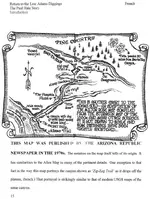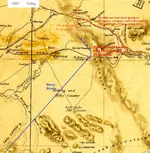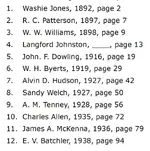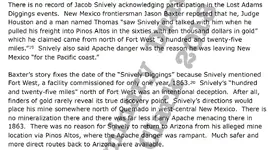Oroblanco
Gold Member
- Joined
- Jan 21, 2005
- Messages
- 7,841
- Reaction score
- 9,872
- Golden Thread
- 0
- Location
- DAKOTA TERRITORY
- Detector(s) used
- Tesoro Lobo Supertraq, (95%) Garrett Scorpion (5%)
Old Bookaroo said:.... “Nearly twenty years ago a man named Adams with seven others came from California into Arizona prospecting. They stopped at Camp Apache for rations and continued east. A few days march from Apache they found a great deal of gold in a small canyon. One of the men, a German, after working about ten days, became alarmed about the Indians and left, carrying about ten or twelve thousand dollars in gold as a result of his labor. This is shown by the books of the Post Trade at Fort Yuma who bought the gold from him....."
A theory pioneered by Jack Purcell identifies Jacob Snively as a likely candidate for the role of 'the Dutchman' of the LAD legends. Snively allegedly rode into Pinos Altos in 1864 with $10,000 worth of placer gold, and later sold it in Yuma ... or so the story goes. However, I haven't seen any solid documentation explaining the source of this story. Snively also supposedly claimed the placer came from a place 125 miles 'north of Pinos Altos', but again, this statement would be hard to hang your hat on.
I wish there was more written about Snively- his life was remarkable, what little we know about him.
You might note that an excellent article concerning this subject was written by Paul Harden titled "The Lost Adams Diggings: Part One" in the El Defensor Chieftain newspaper, Socorro, NM, September 4, 2004. Part two was published October 9, 2004.
You will note that the Apache Chief Nana allowed them to remain in what he called Sno-Ta-Hay ("Where it Lays") canyon and dig for gold and could not pass beyond the waterfall at the end of the canyon.
There is a fair amount known about Jacob Snively. My interest has been mostly with the stage station he ran for the Butterfield Overland Mail Company at Gila City, Arizona. He was responsible for starting the first placer gold rush in Arizona in November 1858. This was in the mountains just south of the Butterfield stage station. His first interest was in prospecting but he made a buck on the side operating the station. Sometime in 1864 he wandered off to the Pinos Altos.I have written about this period of his life in my recently published book The Butterfield Trail and Overland Mail Company in Arizona, 1858-1861.
Unfortunately, the well-known 'Nana/Sno-ta-hay' rendition of the LAD legend, a particularly popular one in the Socorro area, is one of many tellings of the tale, many in conflict with each other. That problem (too much conflicting information) is, of course, a serious burden for the curious.
Yes, I've read the article. It recaps several talking points debated for many years concerning the LAD, and identifies a number of landmarks key to the legend. However, in our fractal world, landmarks such as described in the tales can be found in a number of locations all over the southwest, depending upon the accuracy of the landmarks' descriptions and the eye of the beholder. Not only that, but the landmarks vary considerably among the many versions of the legend. I've got a couple dozen LAD versions, many of them favoring the 'northern' LAD location, ie the west-of-Magdalena towards Alamo/Datil/Zuni vicinity. Many other versions, well-known and not-so-well-known, favor other parts of New Mexico or Arizona. Most of the popular versions are third-hand information at best, some possibly second-hand. None are first-hand. Confident arguments have been made for years that the LAD has been located, but so far, nobody has provided a location where gold has been found. "I've found the LAD, all the clues are there" is not good enough. We need to see the gold.
After reading Col. Brown's report, I wondered if there was a map prepared as part of it. I looked in the Atlas section of the Records, and to my surprise found the Map of the Military Department of New Mexico, Drawn...by Capt. Allen Anderson...1864.
I was acquainted with this famous work from Jack Purcell's book. I had not realized it was from The War of the Rebellion.
For the benefit of those who don't have ready access to this wonderful work of cartographic art, here is the portion showing the country related in Col. Brown's report.
Good luck to all,
~The Old Bookaroo
It's a great resource. It's interesting that place names and locations change over the years.
Springfield, were you able to obtain copies of those field notes?
A theory pioneered by Jack Purcell identifies Jacob Snively as a likely candidate for the role of 'the Dutchman' of the LAD legends. Snively allegedly rode into Pinos Altos in 1864 with $10,000 worth of placer gold, and later sold it in Yuma ... or so the story goes. However, I haven't seen any solid documentation explaining the source of this story. Snively also supposedly claimed the placer came from a place 125 miles 'north of Pinos Altos', but again, this statement would be hard to hang your hat on.
I wish there was more written about Snively- his life was remarkable, what little we know about him.

Springfield, I had been plotting information on Google Earth for a few years now trying to ZERO in on an LAD site. I must be honest that I have not read all of the information that is listed here, however I will make it a point to thoroughly look through everyone's information (whether it seems credible or not). I must say what you say about Snively shocked me, because that "supposed" story about him actually puts me within 5 miles of a probable site that I had marked on the map. Appreciate that information.
Bear Creek, perhaps?




 Curious to see how they differ and match
Curious to see how they differ and match 
YOU ARE THE MAN! I have 4 days off tomorrow, and I'll read each versionCurious to see how they differ and match
I don't understand the Page 2, Page 7 and all that. I can't find what pages you're speaking of.
